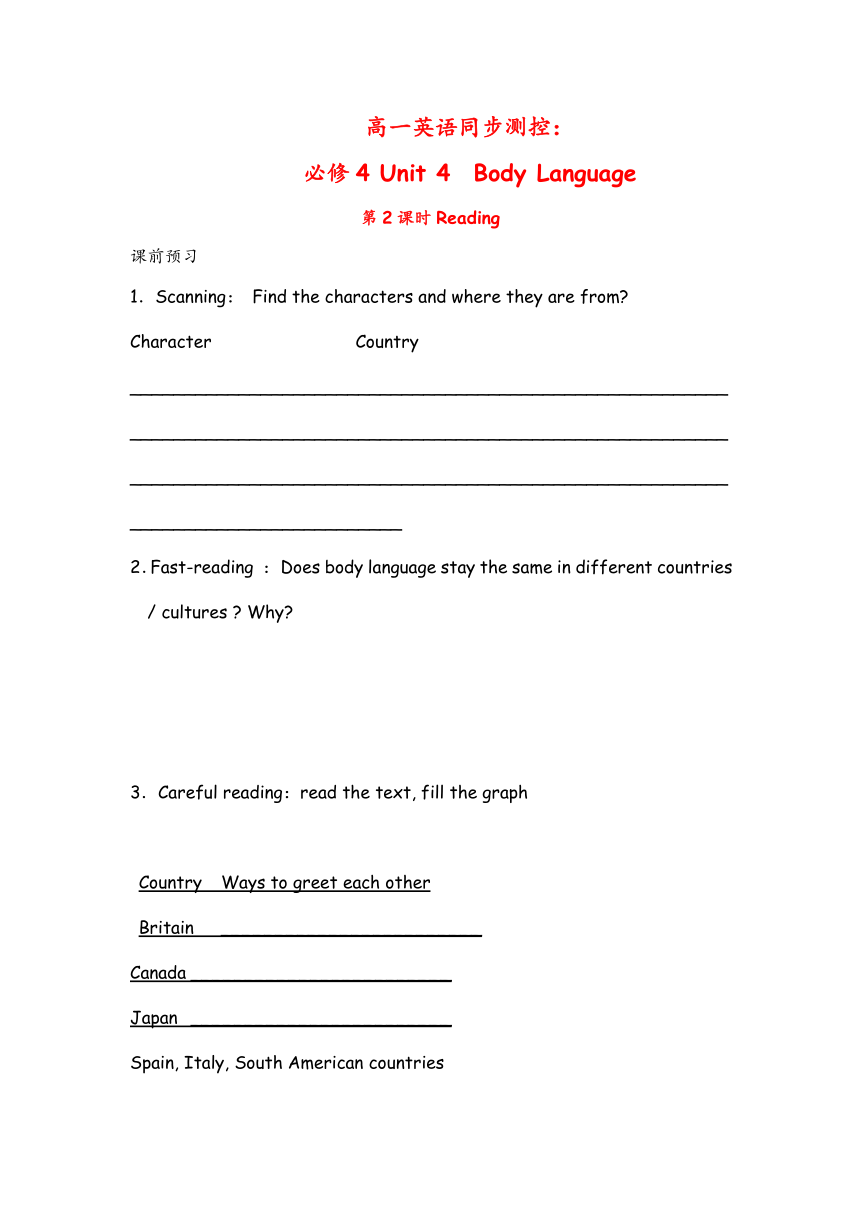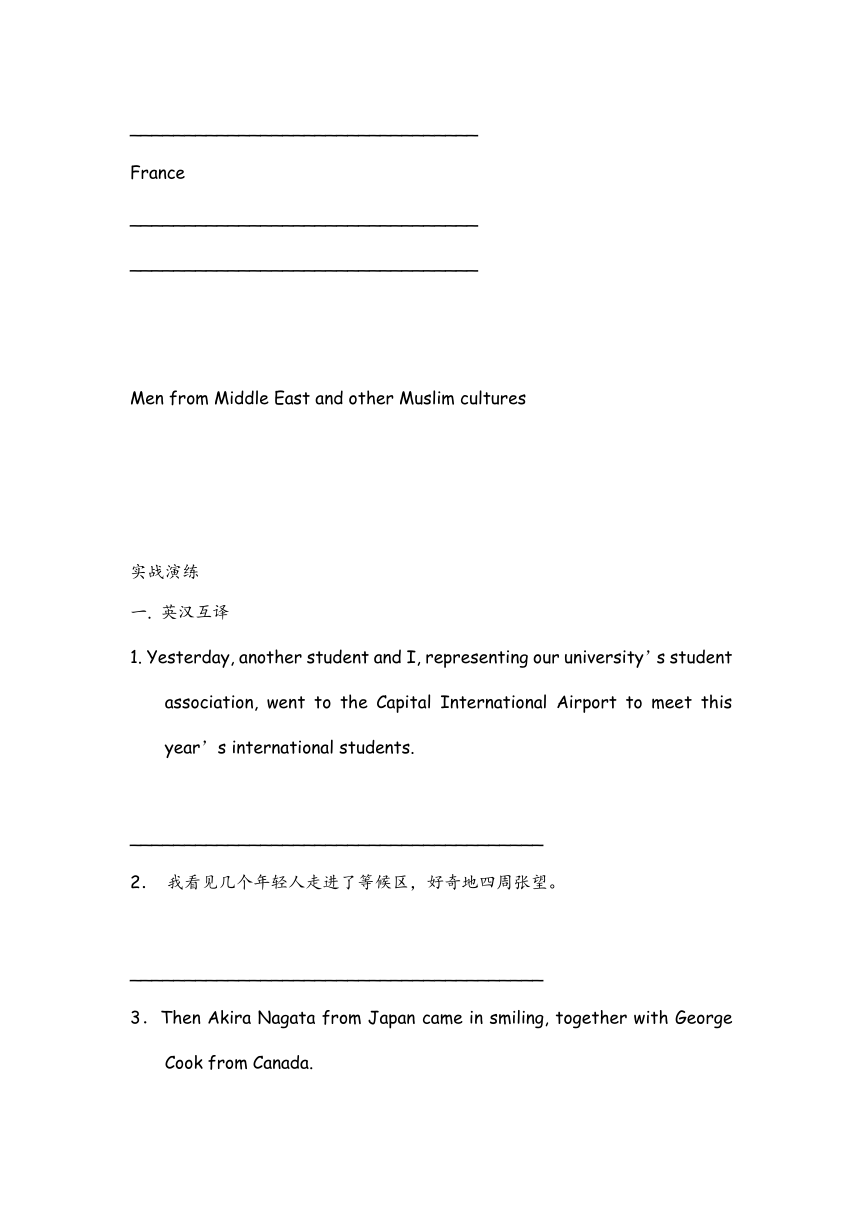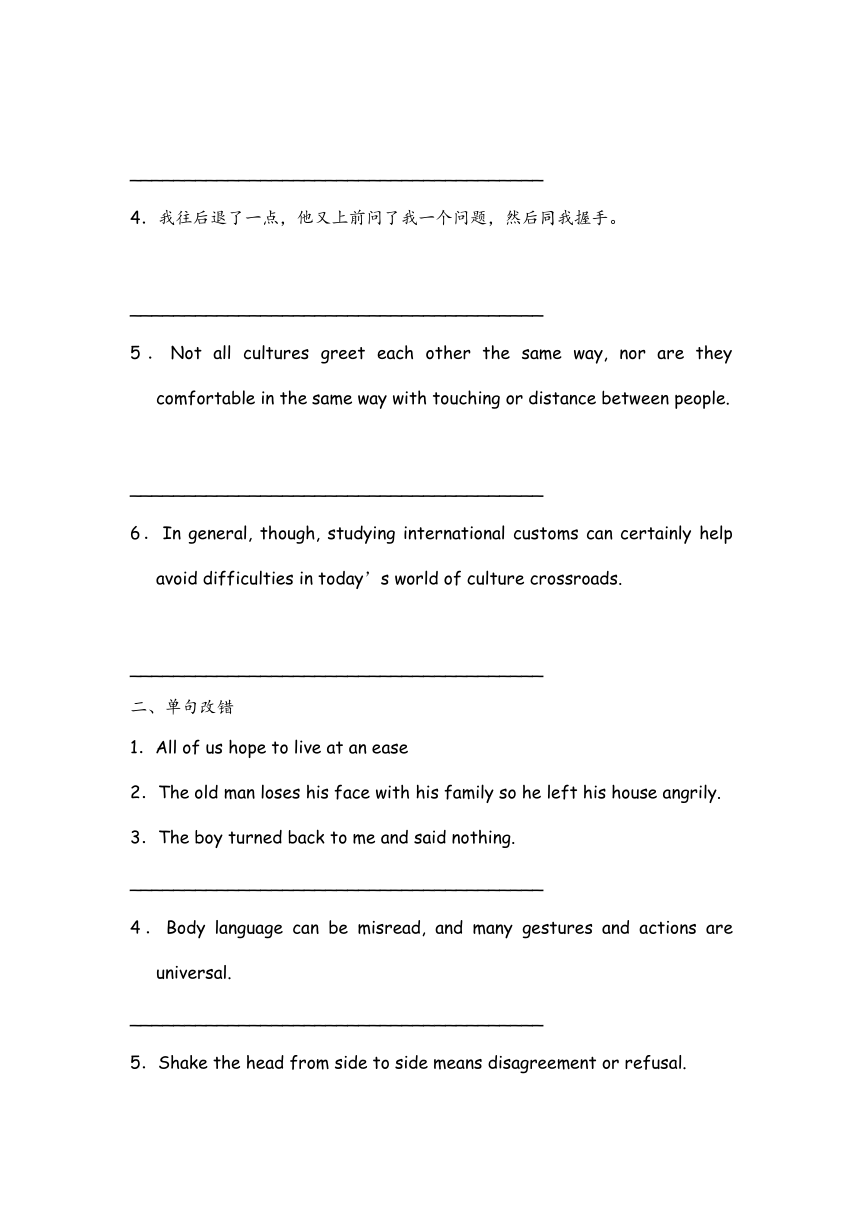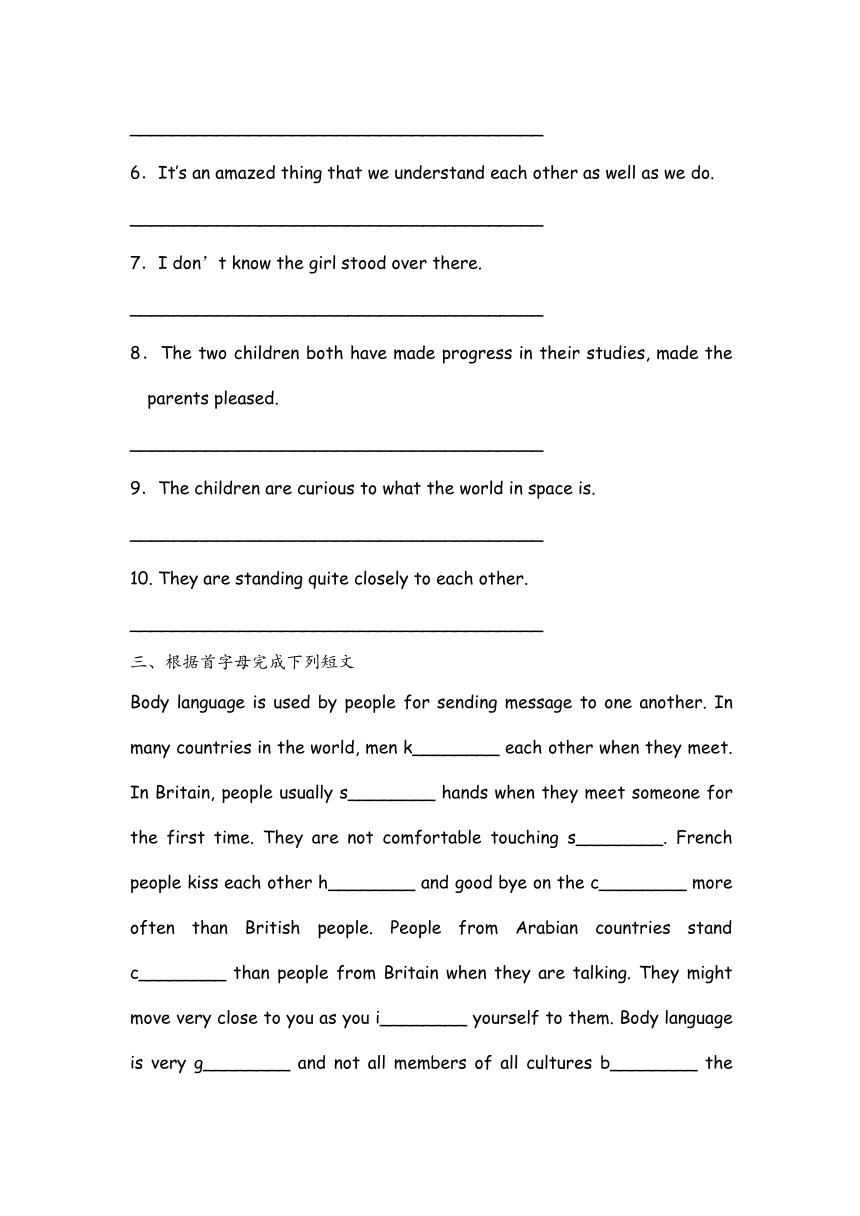高一英语同步测控:Unit 4 Body Language Reading(新人教必修4)
文档属性
| 名称 | 高一英语同步测控:Unit 4 Body Language Reading(新人教必修4) |  | |
| 格式 | zip | ||
| 文件大小 | 16.0KB | ||
| 资源类型 | 教案 | ||
| 版本资源 | 人教版(新课程标准) | ||
| 科目 | 英语 | ||
| 更新时间 | 2011-12-09 07:02:23 | ||
图片预览




文档简介
高一英语同步测控:
必修4 Unit 4 Body Language
第2课时Reading
课前预习
1.Scanning: Find the characters and where they are from
Character Country
______________________________________________________________________________________________________________________________________________________________________________________________
2.Fast-reading : Does body language stay the same in different countries / cultures Why
3.Careful reading:read the text, fill the graph
Country Ways to greet each other
Britain ________________________
Canada ________________________
Japan ________________________
Spain, Italy, South American countries
________________________________
France
________________________________
________________________________
Men from Middle East and other Muslim cultures
实战演练
一. 英汉互译
1. Yesterday, another student and I, representing our university’s student association, went to the Capital International Airport to meet this year’s international students.
______________________________________
2. 我看见几个年轻人走进了等候区,好奇地四周张望。
______________________________________
3.Then Akira Nagata from Japan came in smiling, together with George Cook from Canada.
______________________________________
4.我往后退了一点,他又上前问了我一个问题,然后同我握手。
______________________________________
5.Not all cultures greet each other the same way, nor are they comfortable in the same way with touching or distance between people.
______________________________________
6.In general, though, studying international customs can certainly help avoid difficulties in today’s world of culture crossroads.
______________________________________
二、单句改错
1.All of us hope to live at an ease
2.The old man loses his face with his family so he left his house angrily.
3.The boy turned back to me and said nothing.
______________________________________
4.Body language can be misread, and many gestures and actions are universal.
______________________________________
5.Shake the head from side to side means disagreement or refusal.
______________________________________
6.It’s an amazed thing that we understand each other as well as we do.
______________________________________
7.I don’t know the girl stood over there.
______________________________________
8.The two children both have made progress in their studies, made the parents pleased.
______________________________________
9.The children are curious to what the world in space is.
______________________________________
10. They are standing quite closely to each other.
______________________________________
三、根据首字母完成下列短文
Body language is used by people for sending message to one another. In many countries in the world, men k________ each other when they meet. In Britain, people usually s________ hands when they meet someone for the first time. They are not comfortable touching s________. French people kiss each other h________ and good bye on the c________ more often than British people. People from Arabian countries stand c________ than people from Britain when they are talking. They might move very close to you as you i________ yourself to them. Body language is very g________ and not all members of all cultures b________ the same way. Using body language in a correct way will help you to c________ with others.
反馈检测:
阅读理解
There is one language that is used in every country in the world. The people who use it are young and old, short and tall, thin and fat. It is everybody’s second language. It is easy to understand, although you can’t hear it. It is sign language.
When you wave to a friend who is crossing the road, you are using sign language. When you smile at someone, you are saying, “I want to be friendly”, but you are not using speech. You are using sign language. When you raise your hand in class, you are saying, “please ask me, I think I know the correct answer.”
Babies who can’t talk can point at things. They are using sign language. A policeman who wants to stop traffic holds up his hands. He is using sign language.
Many years ago, a French priest, Charles Michel. Depee became interested in education for deaf people. He invented a finger alphabet. It is still in use. People can make the sign for letters and spell words with their hands, and deaf people can read and understand them. Soon there were schools for the deaf in many countries. The only university for the deaf is Gallaudet college in Washington,D.C.
Today in the United States, there is special TV news in sign language. At the same time, words appear on the TV screen.
The Actors in the Theatre of Deaf don’t spell every word. Sometimes they use hand signs. When they put two hands together, it means sandwich. They can make a roof with their hands when they want to show a house. One finger in front of an actor’s mouth can mean quiet. You can talk to people who are behind windows that are closed. And when you go swimming with your friends, you can have conversations under water.
How many hand signs do you use every day
1.Which of the following about sign language is true
A. It is special language used in a few countries in the world.
B. It’s a way to express one’s ideas without words.
C. It’s only used by the deaf. D. It can be heard.
2.If you want to express the idea that “I’m very friendly” to someone, you will_____
A. raise your hands B. put one hand onto the other
C. smile to the person D. make a roof with your hands
3.Which of the following is true according to the passage
A. Hand signs instead of finger signs are used every day.
B. There are schools, colleges and universities for the deaf in the USA.
C. The French priest Charles invented sign language.
D. Even babies are using sign language.
4.The passage is mainly about_____
A. an introduction to sign language B. the importance of sign language
C. a famous priest in France D. how to use sign language
第2课时: Reading
课前预习
一、
Character Country
Tony Garcia Colombia
Julia Smith Britain
Mr. Cook Canada
Akira Nagata Japan
Ahmed Aziz Jordan
Madame Coulon France
I China
二、No, body language varies from culture to culture. Because cultures have developed in different ways.
三、
country Ways to greet each other
Britain Shake hands
Don’t stand very close to others or touch strangers when they meet
Canada Shake hands
Japan bow
Spain, Italy, South American countries Approach others closely and are more likely to touch them
France Shake hands and kiss each other twice on each cheek
Men from Middle East and other Muslim cultures
Shake hands and stand quite close to other men nod to women and do not shake hands with them
实战演练
一、英汉互译
1. 昨天,我和另一个同学代表我们大学的学生会去首都国际机场迎接今年的国际学生
2. I saw several young people enter the waiting area looking around curiously.
3. 随后来自日本的永田明微笑着走了进来,同时进来的还有加拿大的乔治.库克。
4. I moved back a bit, but he came closer to ask a question and then shook my hand.
5. 各种文化背景下的人互致问候的方式不尽相同,身体接触和相互间距的程度也不尽相同。
6. 但是总的来说,在当今文化交融的世界,学习不同国家的习俗肯定能帮助我们避免交往中的困难。
二、单句改错
1. 删去an; 2 . loses改lost ;3. turned后加his ;4. and改but ;5. shake改shaking;
6. amazed改amazing; 7. stood改standing; 8. made改making; 9. to改about;
10. closely改close;
三、根据首字母完成下列短文
kiss, shake, strangers, hello, cheek, closer, introduce, general, behave, communicate
反馈检测
阅读:BCDA
必修4 Unit 4 Body Language
第2课时Reading
课前预习
1.Scanning: Find the characters and where they are from
Character Country
______________________________________________________________________________________________________________________________________________________________________________________________
2.Fast-reading : Does body language stay the same in different countries / cultures Why
3.Careful reading:read the text, fill the graph
Country Ways to greet each other
Britain ________________________
Canada ________________________
Japan ________________________
Spain, Italy, South American countries
________________________________
France
________________________________
________________________________
Men from Middle East and other Muslim cultures
实战演练
一. 英汉互译
1. Yesterday, another student and I, representing our university’s student association, went to the Capital International Airport to meet this year’s international students.
______________________________________
2. 我看见几个年轻人走进了等候区,好奇地四周张望。
______________________________________
3.Then Akira Nagata from Japan came in smiling, together with George Cook from Canada.
______________________________________
4.我往后退了一点,他又上前问了我一个问题,然后同我握手。
______________________________________
5.Not all cultures greet each other the same way, nor are they comfortable in the same way with touching or distance between people.
______________________________________
6.In general, though, studying international customs can certainly help avoid difficulties in today’s world of culture crossroads.
______________________________________
二、单句改错
1.All of us hope to live at an ease
2.The old man loses his face with his family so he left his house angrily.
3.The boy turned back to me and said nothing.
______________________________________
4.Body language can be misread, and many gestures and actions are universal.
______________________________________
5.Shake the head from side to side means disagreement or refusal.
______________________________________
6.It’s an amazed thing that we understand each other as well as we do.
______________________________________
7.I don’t know the girl stood over there.
______________________________________
8.The two children both have made progress in their studies, made the parents pleased.
______________________________________
9.The children are curious to what the world in space is.
______________________________________
10. They are standing quite closely to each other.
______________________________________
三、根据首字母完成下列短文
Body language is used by people for sending message to one another. In many countries in the world, men k________ each other when they meet. In Britain, people usually s________ hands when they meet someone for the first time. They are not comfortable touching s________. French people kiss each other h________ and good bye on the c________ more often than British people. People from Arabian countries stand c________ than people from Britain when they are talking. They might move very close to you as you i________ yourself to them. Body language is very g________ and not all members of all cultures b________ the same way. Using body language in a correct way will help you to c________ with others.
反馈检测:
阅读理解
There is one language that is used in every country in the world. The people who use it are young and old, short and tall, thin and fat. It is everybody’s second language. It is easy to understand, although you can’t hear it. It is sign language.
When you wave to a friend who is crossing the road, you are using sign language. When you smile at someone, you are saying, “I want to be friendly”, but you are not using speech. You are using sign language. When you raise your hand in class, you are saying, “please ask me, I think I know the correct answer.”
Babies who can’t talk can point at things. They are using sign language. A policeman who wants to stop traffic holds up his hands. He is using sign language.
Many years ago, a French priest, Charles Michel. Depee became interested in education for deaf people. He invented a finger alphabet. It is still in use. People can make the sign for letters and spell words with their hands, and deaf people can read and understand them. Soon there were schools for the deaf in many countries. The only university for the deaf is Gallaudet college in Washington,D.C.
Today in the United States, there is special TV news in sign language. At the same time, words appear on the TV screen.
The Actors in the Theatre of Deaf don’t spell every word. Sometimes they use hand signs. When they put two hands together, it means sandwich. They can make a roof with their hands when they want to show a house. One finger in front of an actor’s mouth can mean quiet. You can talk to people who are behind windows that are closed. And when you go swimming with your friends, you can have conversations under water.
How many hand signs do you use every day
1.Which of the following about sign language is true
A. It is special language used in a few countries in the world.
B. It’s a way to express one’s ideas without words.
C. It’s only used by the deaf. D. It can be heard.
2.If you want to express the idea that “I’m very friendly” to someone, you will_____
A. raise your hands B. put one hand onto the other
C. smile to the person D. make a roof with your hands
3.Which of the following is true according to the passage
A. Hand signs instead of finger signs are used every day.
B. There are schools, colleges and universities for the deaf in the USA.
C. The French priest Charles invented sign language.
D. Even babies are using sign language.
4.The passage is mainly about_____
A. an introduction to sign language B. the importance of sign language
C. a famous priest in France D. how to use sign language
第2课时: Reading
课前预习
一、
Character Country
Tony Garcia Colombia
Julia Smith Britain
Mr. Cook Canada
Akira Nagata Japan
Ahmed Aziz Jordan
Madame Coulon France
I China
二、No, body language varies from culture to culture. Because cultures have developed in different ways.
三、
country Ways to greet each other
Britain Shake hands
Don’t stand very close to others or touch strangers when they meet
Canada Shake hands
Japan bow
Spain, Italy, South American countries Approach others closely and are more likely to touch them
France Shake hands and kiss each other twice on each cheek
Men from Middle East and other Muslim cultures
Shake hands and stand quite close to other men nod to women and do not shake hands with them
实战演练
一、英汉互译
1. 昨天,我和另一个同学代表我们大学的学生会去首都国际机场迎接今年的国际学生
2. I saw several young people enter the waiting area looking around curiously.
3. 随后来自日本的永田明微笑着走了进来,同时进来的还有加拿大的乔治.库克。
4. I moved back a bit, but he came closer to ask a question and then shook my hand.
5. 各种文化背景下的人互致问候的方式不尽相同,身体接触和相互间距的程度也不尽相同。
6. 但是总的来说,在当今文化交融的世界,学习不同国家的习俗肯定能帮助我们避免交往中的困难。
二、单句改错
1. 删去an; 2 . loses改lost ;3. turned后加his ;4. and改but ;5. shake改shaking;
6. amazed改amazing; 7. stood改standing; 8. made改making; 9. to改about;
10. closely改close;
三、根据首字母完成下列短文
kiss, shake, strangers, hello, cheek, closer, introduce, general, behave, communicate
反馈检测
阅读:BCDA
同课章节目录
